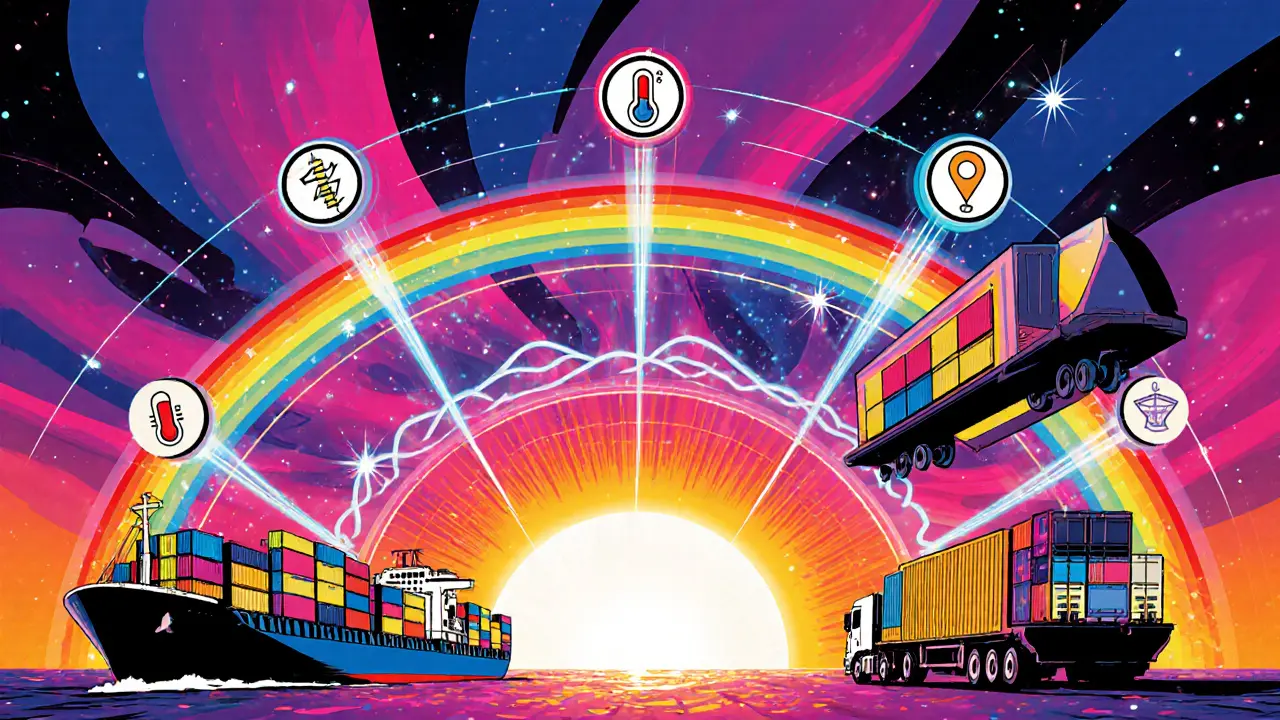Recall Time Calculator
Time Savings Calculator
Compare traditional recall identification times with blockchain-powered supply chains.
Results
vs. traditional systems
When you hear Supply Chain Blockchain a distributed ledger that records every hand‑off, sensor reading, and contract in a supply network, the first question is usually: “What can it actually do for my business?” The answer lies in a handful of concrete use cases that turn vague promises of transparency into measurable results-faster recalls, lower costs, and smarter automation.
How blockchain fits into a supply chain
Traditional supply‑chain software relies on central databases that each partner updates manually. That creates information silos, version conflicts, and a lot of paperwork. A blockchain replaces the central hub with an immutable ledger that every participant can read in real time. When a sensor logs temperature, a smart‑contract checks the value against preset limits, and the result is stamped on the chain for all parties to see instantly.
Core technical building blocks
- Distributed ledger: Each node stores the same copy of transaction data, preventing unilateral changes.
- Smart contracts Smart Contracts self‑executing code that triggers actions when predefined conditions are met: automate payments, alerts, or compliance steps.
- IoT sensor integration: Temperature, humidity, vibration, GPS, and other data are written directly to the chain, creating a tamper‑proof audit trail.
- Tokenization: Physical goods are represented by digital tokens, enabling faster settlement and easier financing.
High‑impact use cases
Below are the most widely adopted scenarios, each backed by real‑world pilots or deployments.
1. End‑to‑end traceability
Maersk’s TradeLens platform, built with IBM, was one of the first global cargo‑tracking blockchains. By logging every container movement, shippers can verify a product’s path from raw material to shelf in seconds instead of weeks.
2. Cold‑chain monitoring (pharma & food)
During the COVID‑19 vaccine rollout, Moderna used a blockchain‑enabled sensor network to keep mRNA doses at -70°C. Any temperature breach automatically triggered a smart‑contract‑based alert, preventing compromised doses from reaching patients. The same approach is now standard for perishable foods like seafood and dairy.
3. Rapid food‑recall identification
Walmart’s blockchain pilot reduced the time to pinpoint contaminated lettuce from an average of 7 days to under 2 minutes. By scanning a QR code on the package, the retailer accessed a full ledger of farm, processing, and transport events, isolating the affected batch instantly.
4. Automotive parts provenance
Ford announced a blockchain system to trace cobalt used in electric‑vehicle batteries. The ledger records mining, smelting, and shipping steps, giving regulators proof that conflict‑free minerals are used.
5. Diamond provenance
De Beers tracks high‑value diamonds from mine to retail on a private blockchain, eliminating the risk of conflict diamonds and providing buyers with immutable proof of origin.
6. Oil‑field logistics
ADNOC partnered with IBM to log each barrel’s journey from wellhead to refinery. The chain automates payment triggers when delivery milestones are confirmed, cutting reconciliation time by 30%.
7. Freight dispute resolution
FedEx joined the Blockchain in Transport Alliance (BiTA) and launched a pilot that stores shipment proofs of delivery on a blockchain. When customers dispute charges, the immutable record settles the matter without lengthy email chains.
8. Sustainable financing for small suppliers
Tokenized inventory on a blockchain lets small farms obtain working capital from decentralized finance platforms. Lenders see the real‑time token value, reducing risk and accelerating loan approval.

Benefits measured in the field
| Metric | Traditional approach | Blockchain‑enabled approach |
|---|---|---|
| Recall identification time | ~60 days | Seconds to minutes |
| Processing cost reduction | Baseline | Up to 40 % (Tracifier case) |
| Inventory tracking overhead | Manual audits, 5‑10 % of labor | Automated, < 2 % of labor |
| Payment settlement time | Weeks after invoice | Instant via smart contracts |
Implementation considerations
Deploying a blockchain isn’t a plug‑and‑play switch. Companies typically face three phases:
- Proof‑of‑concept: Connect a few trusted partners, test sensor data ingestion, and validate smart‑contract logic. Projects like Tracifier’s Oracle integration can be up and running within three months for simple traceability.
- Scale‑out: Expand network membership, integrate ERP systems (SAP, Oracle), and onboard additional IoT devices. Expect 6‑12 months for a multi‑partner roll‑out.
- Optimization: Add tokenization, AI‑driven analytics, and automated financing. This is an ongoing effort that can stretch over years.
Key resource needs include:
- Technical expertise in distributed ledger protocols (Hyperledger Fabric, Ethereum Enterprise).
- Smart‑contract developers to write and audit code.
- IoT hardware and connectivity for real‑time sensor capture.
- Change‑management teams to train partners on new data‑sharing habits.

Future trends shaping the next wave
Experts say the next evolution will move beyond passive record‑keeping to active supply‑chain orchestration.
- Tokenized assets: Physical goods become digital tokens, enabling instant settlement and new financing models.
- AI‑enhanced analytics: Blockchain data feeds AI engines that predict demand spikes or temperature risks before they happen.
- Integrated IoT‑AI loops: Sensors trigger smart contracts, which then feed data to AI for continuous process improvement.
- Regulatory compliance dashboards: Real‑time carbon‑footprint reporting becomes mandatory for many industries; blockchain provides the auditable trail.
Quick takeaways
- Supply chain blockchain turns fragmented data into a single, tamper‑proof ledger.
- Real‑world pilots have cut recall times from months to seconds and reduced processing costs by up to 40 %.
- Key use cases include traceability, cold‑chain monitoring, parts provenance, and automated payments.
- Implementation starts with a focused proof‑of‑concept, then scales to multi‑partner networks.
- Future growth will be driven by tokenization, AI, and tighter regulatory demands.
What makes blockchain different from a regular database for supply chains?
A blockchain stores data across many independent nodes, so no single party can rewrite history. This immutability, combined with smart‑contract automation, gives all partners a trustworthy, real‑time view of every transaction.
Which industries are leading blockchain adoption today?
Food & beverage, pharmaceuticals, automotive, diamonds, oil & gas, and logistics companies like FedEx are the most active pilots, largely because they need traceability for safety or regulatory reasons.
How long does a typical blockchain supply‑chain project take?
A simple traceability proof‑of‑concept can be live in 3‑4 months. Full‑scale, multi‑partner networks usually need 6‑12 months for integration and testing.
What are the biggest challenges when adopting blockchain?
Common hurdles include legacy system integration, the need for skilled smart‑contract developers, upfront sensor hardware costs, and reaching consensus among many independent trading partners.
Can blockchain reduce supply‑chain fraud?
Yes. Because every hand‑off is permanently recorded, attempts to alter provenance-like swapping a genuine product for a counterfeit-are instantly visible to all parties, drastically lowering fraud risk.

Write a comment